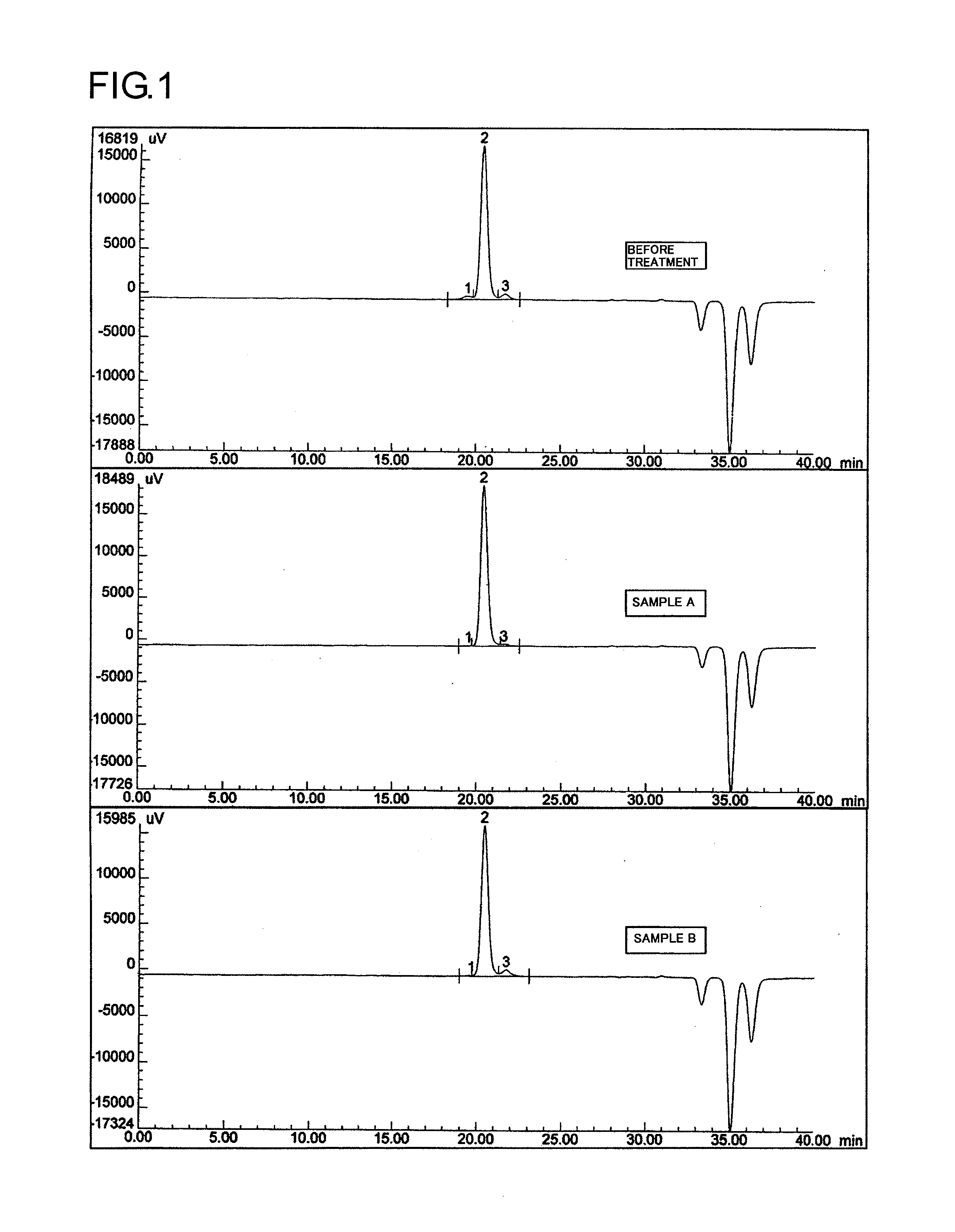Purification method of high-molecular-weight polyoxyalkylene derivative
- Summary
- Abstract
- Description
- Claims
- Application Information
AI Technical Summary
Benefits of technology
Problems solved by technology
Method used
Image
Examples
example 1-1
[0119]Into a 5-L four-necked flask were introduced 100 g of methoxypolyethylene glycol (hereinafter referred to as mPEG) (molecular weight, 30,000; diol content, 2.81%) and 1,500 g (1,700 mL) of toluene. A Three-One Motor, a condenser, and a nitrogen bubbling tube were attached thereto, and the mPEG was dissolved at 55° C. using a mantle heater. Two hundred grams of Kyoward 200B (Kyowa Chemical Industry) was added thereto, and the mixture was stirred at 55° C. for 1 hour. A Nutsche funnel with 5 A filter paper was prepared, and the mixture was subjected to suction filtration. The filtrate was recovered. To the recovered filtrate was added 1,000 g of hexane to cause crystallization. The crystals precipitated were taken out by filtration and vacuum-dried, and a sample was recovered (50 g).
[0120]As a result of GPC analysis, the sample was found to have a diol content of 0.3%.
[0121]In Examples 1-2 to 1-24, experiments were conducted according to the operation of Example 1, except that t...
examples 1-1 to 1-7
Examples in which the Kind of Solvent was Changed
[0122]Into a 5-L four-necked flask were introduced 100 g of mPEG (molecular weight, 30,000; diol content, 2.81%) and 1,700 mL of any of the solvents shown in the following table. A Three-One Motor, a condenser, and a nitrogen bubbling tube were attached thereto, and the mPEG was dissolved at around 40° C. using a mantle heater. Two hundred grams of Kyoward 200B (Kyowa Chemical Industry) was added thereto, and the mixture was stirred for 1 hour at a temperature which was 40° C. to 55° C. and not higher than the boiling point of the solvent. A Nutsche funnel with 5 A filter paper was prepared, and the mixture was subjected to suction filtration. The filtrate was recovered. To the recovered filtrate was added 1,000 g of hexane to cause crystallization. The crystals precipitated were taken out by filtration and vacuum-dried to recover a sample. With respect to chloroform, acetone, tetrahydrofuran, and dichloromethane, a sample was recover...
examples 1-8 to 1-13
Examples in which Solvent Amount was Changed
[0126]Into a 5-L four-necked flask were introduced 100 g of mPEG (molecular weight, 30,000; diol content, 2.81%) and toluene (amount is shown in the table). A Three-One Motor, a condenser, and a nitrogen bubbling tube were attached thereto, and the mPEG was dissolved at 55° C. using a mantle heater. Two hundred grams of Kyoward 200B (Kyowa Chemical Industry) was added thereto, and the mixture was stirred at 55° C. for 1 hour. A Nutsche funnel with 5 A filter paper was prepared, and the mixture was subjected to suction filtration. The filtrate was recovered. To the recovered filtrate was added 1,000 g of hexane to cause crystallization. The crystals precipitated were taken out by filtration and vacuum-dried, and a sample was recovered.
TABLE 7Example1-81-91-11-101-111-121-13 Toluene, times by7.5101520253050weight (based onmPEG)Content of diol (%)0.850.60.30.230.310.070.27Yield (%)39445047485054
[0127]The results given above show that small so...
PUM
| Property | Measurement | Unit |
|---|---|---|
| Temperature | aaaaa | aaaaa |
| Weight | aaaaa | aaaaa |
| Molecular weight | aaaaa | aaaaa |
Abstract
Description
Claims
Application Information
 Login to View More
Login to View More - R&D
- Intellectual Property
- Life Sciences
- Materials
- Tech Scout
- Unparalleled Data Quality
- Higher Quality Content
- 60% Fewer Hallucinations
Browse by: Latest US Patents, China's latest patents, Technical Efficacy Thesaurus, Application Domain, Technology Topic, Popular Technical Reports.
© 2025 PatSnap. All rights reserved.Legal|Privacy policy|Modern Slavery Act Transparency Statement|Sitemap|About US| Contact US: help@patsnap.com



